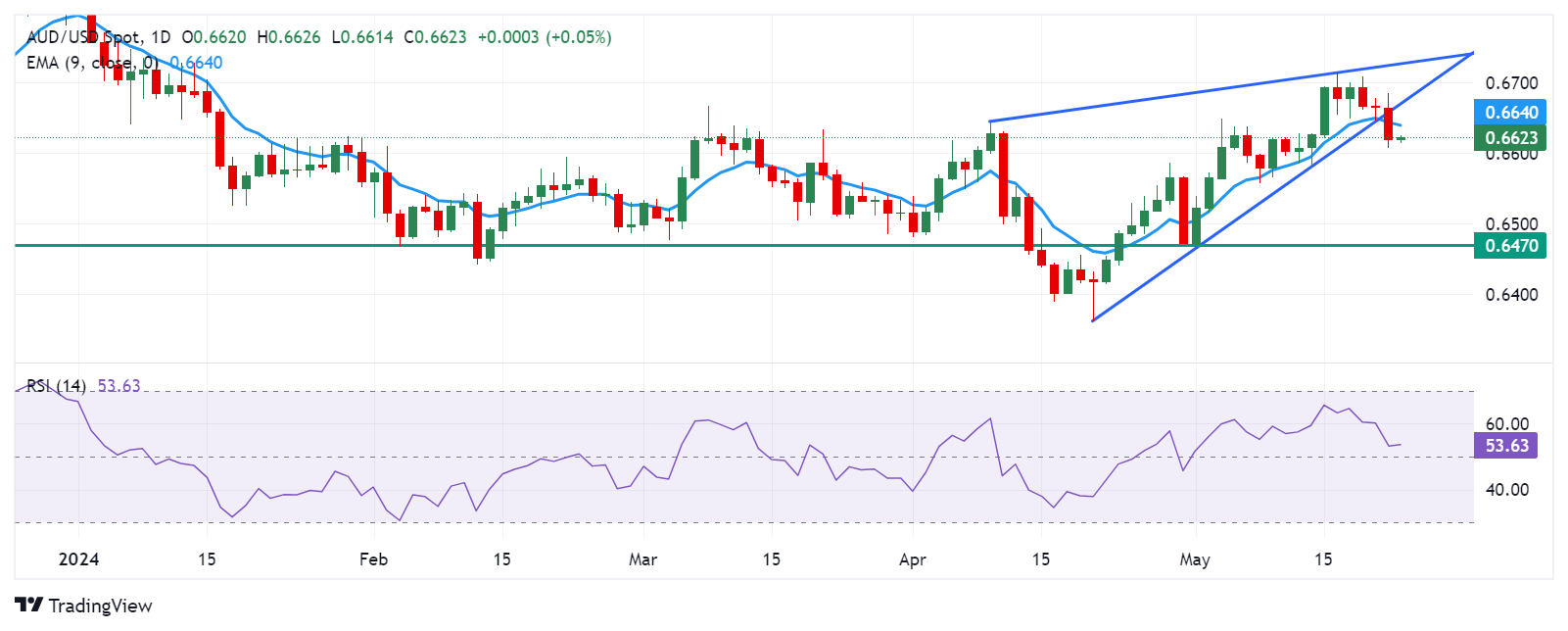The Australian Dollar appreciates ahead of US PMI data on Thursday.
Australia’s Consumer inflation expectations dropped to 4.1% in May from 4.6% in April, hitting the lowest point since October 2021.
FOMC Minutes suggested a lack of progress on inflation, casting doubt on the Fed’s willingness to proceed with rate cuts.
The Australian Dollar (AUD) halts its three-day losing streak on Thursday, possibly driven by the improved risk appetite. However, the Aussie Dollar came under pressure following the Consumer Inflation Expectation, released by the Melbourne Institute. Consumer expectations of future inflation over the next 12 months fell to 4.1% in May from 4.6% in April, marking the lowest level since October 2021.
Australian private sector activity remained expansionary for the fourth straight month in May. The preliminary Judo Bank Composite Purchasing Managers Index (PMI) decreased to 52.6 in May from April’s reading of 53.0, indicating a slight moderation in growth. The growth was mainly fueled by an expansion in the services sector, while the decline in manufacturing output slowed down.
The US Dollar (USD) remains strong following recent gains, as the minutes from the latest Federal Open Market Committee (FOMC) policy meeting were released on Wednesday. Federal Reserve (Fed) policymakers expressed concerns about the lack of progress on inflation, which has proven to be more persistent than expected at the start of 2024. As a result, the Fed is hesitant to proceed with interest rate cuts.
Daily Digest Market Movers: Australian Dollar inches higher due to risk-on mood
Tensions are escalating following Lai Ching-te’s assumption of office as Taiwan’s new president. Chinese state media reports indicate that China has deployed numerous fighter jets and conducted simulated strikes in specific areas in the region, including actions from naval vessels. Any geopolitical tension in the region may impact the Australian market as China and Australia are both close trade partners.
The Judo Bank Australia Services PMI was 53.1 in May, down from April’s reading of 53.6. This marks the fourth consecutive month of expansion, albeit at a slower yet still solid pace. The Manufacturing PMI remained unchanged at 49.6 in May, indicating that manufacturing conditions continued to deteriorate for the fourth consecutive month.
The ASX 200 Index moves below 7,800 on Thursday due to declines in mining and energy stocks following a significant drop in commodity prices. Additionally, Australian shares were influenced by a weak performance on Wall Street overnight after FOMC meeting minutes suggested concerns about the slow progress on inflation.
According to the CME FedWatch Tool, the probability of the Federal Reserve implementing a 25 basis-point rate cut in September has seen a slight downtick to 50.7%, compared to 51.6% a day ago.
Federal Reserve Bank of Boston President Susan Collins spoke at the event titled “Central Banking in the Post-Pandemic Financial System” on Tuesday. Collins stated that progress toward interest rate adjustment will take longer and emphasized that patience is the right policy for the Fed, per Reuters. Fed Governor Christopher Waller stated that he needs to see several more months of favorable inflation data before he would be comfortable supporting an easing in policy.
Minutes from the RBA meeting in May 2024 showed that the board considered raising rates but ultimately judged the case for maintaining a steady policy to be stronger. Policymakers agreed that it was challenging to either rule in or rule out future changes in the cash rate. They noted that the flow of data had increased the risk of inflation remaining above the target for an extended period.
Technical Analysis: Australian Dollar remains below a key level of 0.6650
The Australian Dollar trades around 0.6620 on Thursday. The Analysis of the daily chart indicates a weakening of a bullish bias as the AUD/USD pair has breached below the lower boundary of the rising wedge. Despite this, the 14-day Relative Strength Index (RSI) remains slightly above the 50 level. However, a further decline in this momentum indicator could confirm a bearish bias.
The psychological support level of 0.6600 is significant. A continued decline may increase pressure on the AUD/USD pair, potentially leading it toward the throwback support region at 0.6470.
Conversely, the nine-day Exponential Moving Average (EMA) at 0.6639 could pose immediate resistance, followed by the major level of 0.6650. Breaking above the lower boundary of the rising wedge could reinforce the prevailing bullish bias for the AUD/USD pair.
AUD/USD: Daily Chart

Australian Dollar price today
The table below shows the percentage change of the Australian Dollar (AUD) against listed major currencies today. The Australian Dollar was the strongest against the Japanese Yen.
USD
EUR
GBP
CAD
AUD
JPY
NZD
CHF
USD
-0.05%
-0.08%
-0.09%
-0.19%
0.03%
-0.37%
-0.09%
EUR
0.05%
-0.04%
-0.02%
-0.13%
0.09%
-0.31%
-0.05%
GBP
0.08%
0.04%
0.01%
-0.10%
0.13%
-0.28%
-0.01%
CAD
0.08%
0.02%
0.00%
-0.09%
0.12%
-0.29%
-0.03%
AUD
0.19%
0.14%
0.10%
0.10%
0.22%
-0.18%
0.09%
JPY
-0.03%
-0.08%
-0.14%
-0.11%
-0.24%
-0.39%
-0.14%
NZD
0.39%
0.31%
0.27%
0.29%
0.17%
0.39%
0.28%
CHF
0.10%
0.05%
0.01%
0.02%
-0.09%
0.14%
-0.27%
The heat map shows percentage changes of major currencies against each other. The base currency is picked from the left column, while the quote currency is picked from the top row. For example, if you pick the Euro from the left column and move along the horizontal line to the Japanese Yen, the percentage change displayed in the box will represent EUR (base)/JPY (quote).
Risk sentiment FAQs
In the world of financial jargon the two widely used terms “risk-on” and “risk off” refer to the level of risk that investors are willing to stomach during the period referenced. In a “risk-on” market, investors are optimistic about the future and more willing to buy risky assets. In a “risk-off” market investors start to ‘play it safe’ because they are worried about the future, and therefore buy less risky assets that are more certain of bringing a return, even if it is relatively modest.
Typically, during periods of “risk-on”, stock markets will rise, most commodities – except Gold – will also gain in value, since they benefit from a positive growth outlook. The currencies of nations that are heavy commodity exporters strengthen because of increased demand, and Cryptocurrencies rise. In a “risk-off” market, Bonds go up – especially major government Bonds – Gold shines, and safe-haven currencies such as the Japanese Yen, Swiss Franc and US Dollar all benefit.
The Australian Dollar (AUD), the Canadian Dollar (CAD), the New Zealand Dollar (NZD) and minor FX like the Ruble (RUB) and the South African Rand (ZAR), all tend to rise in markets that are “risk-on”. This is because the economies of these currencies are heavily reliant on commodity exports for growth, and commodities tend to rise in price during risk-on periods. This is because investors foresee greater demand for raw materials in the future due to heightened economic activity.
The major currencies that tend to rise during periods of “risk-off” are the US Dollar (USD), the Japanese Yen (JPY) and the Swiss Franc (CHF). The US Dollar, because it is the world’s reserve currency, and because in times of crisis investors buy US government debt, which is seen as safe because the largest economy in the world is unlikely to default. The Yen, from increased demand for Japanese government bonds, because a high proportion are held by domestic investors who are unlikely to dump them – even in a crisis. The Swiss Franc, because strict Swiss banking laws offer investors enhanced capital protection.
Information on these pages contains forward-looking statements that involve risks and uncertainties. Markets and instruments profiled on this page are for informational purposes only and should not in any way come across as a recommendation to buy or sell in these assets. You should do your own thorough research before making any investment decisions. FXStreet does not in any way guarantee that this information is free from mistakes, errors, or material misstatements. It also does not guarantee that this information is of a timely nature. Investing in Open Markets involves a great deal of risk, including the loss of all or a portion of your investment, as well as emotional distress. All risks, losses and costs associated with investing, including total loss of principal, are your responsibility. The views and opinions expressed in this article are those of the authors and do not necessarily reflect the official policy or position of FXStreet nor its advertisers. The author will not be held responsible for information that is found at the end of links posted on this page.
If not otherwise explicitly mentioned in the body of the article, at the time of writing, the author has no position in any stock mentioned in this article and no business relationship with any company mentioned. The author has not received compensation for writing this article, other than from FXStreet.
FXStreet and the author do not provide personalized recommendations. The author makes no representations as to the accuracy, completeness, or suitability of this information. FXStreet and the author will not be liable for any errors, omissions or any losses, injuries or damages arising from this information and its display or use. Errors and omissions excepted.
The author and FXStreet are not registered investment advisors and nothing in this article is intended to be investment advice.
>>> Read full article>>>
Copyright for syndicated content belongs to the linked Source : FXStreet – https://www.fxstreet.com/news/australian-dollar-rebounds-due-to-improved-risk-appetite-202405230301































